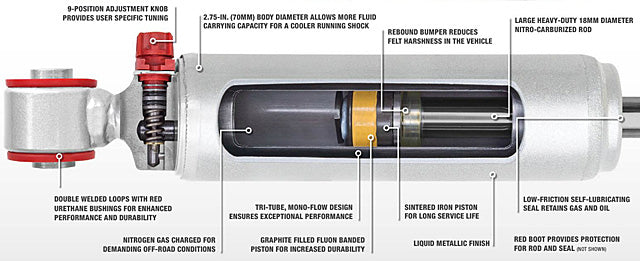
Rancho RS9000, RS9000X or RS9000XL shocks have a small ride-adjustment knob fitted to their base. You simply turn the knob with your fingers. No special tools are needed, and you don’t need to remove the shock from the vehicle in order to make the adjustments.
Usually it takes 60 seconds to go around and adjust all four units.
The adjustment knob has numbered settings embossed into its face. There are nine positions to choose from. The change in stiffness is no gimmick. There is about 400% difference between the softest setting and the firmest.
Number 1 (softest setting) can be set by twisting the knob as far as possible anti-clockwise. Firmer settings are achieved then by turning the knob clockwise. Position 9 is the firmest.
After you have been off-roading, chances are they could be covered with dirt, grime, or mud, making it hard to see the numbers embossed on the ride-adjustment knob, or the alignment arrow mark stamped into the shock body.
Don’t worry. Remember, twisting the knob as far as you can go anti-clockwise takes you to the softest setting (number 1). Then, you can feel the clicks when turning clock-wise from there ( 2-3-4-5′ etc.) so you will know which setting you are at. This means that even with your eyes closed, you can adjust the shocks precisely to your personal preference.

Which settings are best for certain purposes?
Usually you make adjustments to the shock, based on four variables.
(1) The amount of weight or load carried. This includes accessories fitted, passengers, gear, tools and towing. Extra weight places greater demand on your 4WD’s springs, requiring more control or damping from the shocks to ensure good stability. Typically, under heavier loads, you are using a setting between positions 5-9.
(2) The speed you are traveling verses the terrain type. For example, highway and freeway driving is typically high-speed work and the roads are smooth. In this instance, look to firmer settings for more sports-car like handling. Firmer settings provide better control at high speed, and because the roads are smooth, little spring action is required – so tight control over the springs is OK.
(3) Inherent characteristics in a vehicle type. Like people, most vehicles have their quirks. Suspension systems not excluded. (Too soft. Too stiff. Too jerky etc.) On some vehicles with IFS (independent front suspension) there’s often complaint about how soft the front-end control and handling is. With the Rancho adjustable shocks fitted, you can dial the units firmer to compensate to a reasonable degree. Or, if the vehicle’s springs are notably stiff, you can soften the shocks in a lot of circumstances, for a much more comfortable ride.
(4) A combination of all the above. Driving on gravel and corrugated roads often requires good control and handling (firmer settings), yet some ‘give’ in the suspension (softer settings) is also required or the vehicle may track and skitter.
To achieve the best compromise between control and comfort, the load in the vehicle, the speed you are traveling at, and the inherent characteristics of the vehicle all play a part in deciding which settings are ideal.
From experience, in any situation, you are always looking for as comfortable as possible, while maintaining good stability. Mantra… You are always looking for as comfortable as possible, while maintaining good stability.
I recommend that when you first receive your Rancho RS9000XL shocks, set them to mid-range (position 5). This is probably closest to the amount of control you get from the original factory-fitted shocks. Then, from this mid-range setting you can simply ‘up’ or ‘down’ the shocks according to your needs.
Don’t be afraid to try different settings front/rear. Usually our customers will play with the shocks like a kid with a new toy for a few days. Then they will have confidence in the settings that they choose.
If externally ride-adjustable shocks sound too complicated, too fiddly or too much hassle, remember only a little bit of experience is required before you master the settings.
Plus, if you purchase another type of shock, and don’t like the way they ride – what do you do?
4WD1 PTY LTD
P: 1300 004 931
E: sales@4wd1.com
W: www.4wd1.com

Rancho RS9000, RS9000X or RS9000XL shocks have a small ride-adjustment knob fitted to their base. You simply turn the knob with your fingers. No special tools are needed, and you don’t need to remove the shock from the vehicle in order to make the adjustments.
Usually it takes 60 seconds to go around and adjust all four units.


